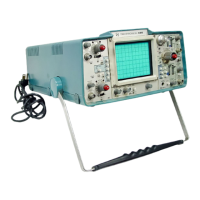Instrument Options-455/A2/B2
4. Set the HORIZ DISPLAY switch to B DLY'D. This
displays the portion of the A Sweep display that was
intensified.
5. If there is too much horizontal jitter, set the B SOURCE
switch to TV LINE and the B Slope switch to the same
polarity as the A SLOPE switch. Adjust the B LEVEL con
trol for a stable display.
With the B SOURCE switch set to STARTS AFTER DELAY
and the A COUPLING switch set to TV FIELD, a stable B
Sweep display of equalizing pulses may be difficult to obtain.
If this is so, trigger B Sweep directly from the signal source.
Use the NORM position of the B SOURCE switch for single
trace displays and the CH 1 or CH 2 positions for dual trace
displays.
VER TIC A L OPERATING M ODES-SPECIAL
CONSIDERATIONS
Single Trace Modes
In the CH 1 and CH 2 vertical modes, any A SOURCE switch
position, except LINE, may be used.
If the display is frequently switched between CH 1 and CH 2,
use the NORM position of the A SOURCE switch. This
eliminates the need to change the A SOURCE switch position
each time the display is switched between CH 1 and CH 2.
When using the NORM or CH 2 positions of the A SOURCE
switch, and when viewing Channel 2 inverted (CH 2 INVERT
switch is set to the in position), the normal setting of the A
SLOPE switch is reversed. This is because the trigger signal
is picked off the Vertical Preamplifier after inversion. In
this case, set the A SLOPE switch to negative (—) for sync
positive input signals and positive (+) for sync-negative input
signals.
Dual Trace Modes
In the ALT or CHOP modes, all positions of the A SOURCE
switch may be used except LINE and NORM. The sync
separator cannot correctly process the signals supplied from
the normal trigger pickoff. Therefore, stable simultaneous
displays of 2 independent video signals that are not gen-
locked together are not possible.
ADD Mode
Any A SOURCE switch position except LINE may be used.
The CH 1 and CH 2 trigger signals are picked off before
signal addition and therefore are not affected by addition.
The normal trigger signal is picked off after signal addition
and therefore, is affected by addition.
When using the ADD Mode with CH 2 inverted, the CH 1
and CH 2 positions of the A SOURCE switch will provide
adequate trigger signals if each individual Channel (when
displayed alone) meets the sensitivity requirements listed in
Table 1.
When the ADD Mode is used to display a full-sized signal
from both sides of a balanced line (CH 2 not inverted), the
NORM position of the A SOURCE switch may be used if
neither signal alone (CH 1 or CH 2 positions of the A SOURCE
switch) is of sufficient amplitude.
When using the ADD mode, the vertical calibration of the
video graticule is valid only if both individual channels are
correctly set up and both VOLTS/DIV switches are set to
the same position.
SELECTING AN IN D IV ID U A L L IN E 1
The Sync Separator does not differentiate between the 2
fields of an interlaced frame or the 4 fields of a PAL color
frame sequence. However, using a 1-1/2 or 3-1/2 field A
sweep cycle, the display will remain locked on a given field
until the trigger signal is interrupted.
One Frame A Sweep Cycle
To display an entire vertical blanking interval and locate a
specific line (e.g., one of the lines containing a specific
VITS waveform), use the following procedure:
ATIM E/D IV 2 ms
B TIM E/DIV 10 ps
B SOURCE
STARTS AFTER
DELAY
A TRIGGER HOLDOFF NORM
HORIZ DISPLAY
A INTEN
A LEVEL
As needed for a
stable display
2. Horizontally position the second vertical blanking interval
to the center of the crt.
1 See Identifying Fields, Frames and Lines in 525/60 and 625/50 TV Systems.
REV. A, OCT 1975
Option 5 Page 3

